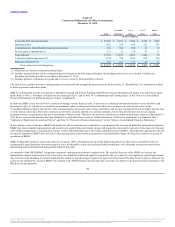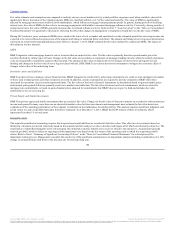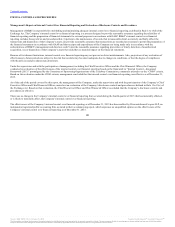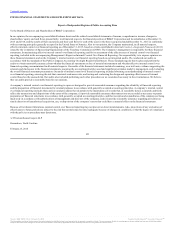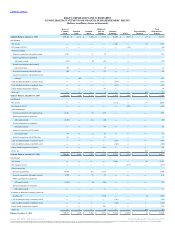BB&T 2015 Annual Report Download - page 85
Download and view the complete annual report
Please find page 85 of the 2015 BB&T annual report below. You can navigate through the pages in the report by either clicking on the pages listed below, or by using the keyword search tool below to find specific information within the annual report.
TableofContents
Fair value estimates and assumptions are compared to industry surveys, recent market activity, actual portfolio experience and, when available, observable
market data. Due to the nature of the valuation inputs, MSRs are classified within Level 3 of the valuation hierarchy. The value of MSRs is significantly
affected by mortgage interest rates available in the marketplace, which influence mortgage loan prepayment speeds. In general, during periods of declining
interest rates, the value of MSRs declines due to increasing prepayments attributable to increased mortgage-refinance activity. Conversely, during periods of
rising interest rates, the value of MSRs generally increases due to reduced refinance activity. Refer to Note 7 “Loan Servicing” in the “Notes to Consolidated
Financial Statements” for quantitative disclosures reflecting the effect that changes in management’s assumptions would have on the fair value of MSRs.
During 2015 and prior years, commercial MSRs were carried at the lower of cost or market and amortized over the estimated period that servicing income was
expected to be received based on projections of the amount and timing of estimated future cash flows. The amount and timing of servicing asset amortization
was based on actual results and updated projections. Effective January 1, 2016, BB&T adopted the fair value method for commercial MSRs. The impact of
this adoption was not material.
LHFS
BB&T originates certain mortgage loans for sale to investors that are carried at fair value. The fair value is primarily based on quoted market prices for
securities backed by similar types of loans. Changes in the fair value are recorded as a component of mortgage banking income, while the related origination
costs are recognized in noninterest expense when incurred. The changes in fair value are largely driven by changes in interest rates subsequent to loan
funding and changes in the fair value of servicing associated with the LHFS. BB&T uses various derivative instruments to mitigate the economic effect of
changes in fair value of the underlying loans.
Derivative Assets and Liabilities
BB&T uses derivatives to manage various financial risks. BB&T mitigates the credit risk by subjecting counterparties to credit reviews and approvals similar
to those used in making loans and other extensions of credit. In addition, certain counterparties are required to provide collateral to BB&T when their
unsecured loss positions exceed certain negotiated limits. The fair values of derivative financial instruments are determined based on quoted market prices
and internal pricing models that are primarily sensitive to market observable data. The fair value of interest rate lock commitments, which are related to
mortgage loan commitments, is based on quoted market prices adjusted for commitments that BB&T does not expect to fund and includes the value
attributable to the net servicing fee.
Private Equity and Similar Investments
BB&T has private equity and similar investments that are carried at fair value. Changes in the fair value of these investments are recorded in other noninterest
income each period. In many cases there are no observable market values for these investments and management must estimate the fair value based on a
comparison of the operating performance of the company to multiples in the marketplace for similar entities. This analysis requires significant judgment, and
actual values in a sale could differ materially from those estimated. As of December 31, 2015, BB&T had $289 million of these investments, which
represented less than 1% of total assets.
Intangible Assets
The acquisition method of accounting requires that acquired assets and liabilities are recorded at their fair values. This often involves estimates based on
third party valuations or internal valuations based on discounted cash flow analyses or other valuation techniques, all of which are inherently subjective. The
amortization of identified intangible assets is based upon the estimated economic benefits to be received, which is also subjective. Acquisitions typically
result in goodwill, which is subject to ongoing periodic impairment tests based on the fair values of the reporting units to which the acquired goodwill
relates. Refer to Note 1 “Summary of Significant Accounting Policies” in the “Notes to Consolidated Financial Statements” for a description of the
impairment testing process. Management considers the sensitivity of the significant assumptions in its impairment analysis including consideration of a 10%
change in estimated future cash flows or the discount rate for each reporting unit.
78
Source: BB&T CORP, 10-K, February 25, 2016 Powered by Morningstar® Document Research℠
The information contained herein may not be copied, adapted or distributed and is not warranted to be accurate, complete or timely. The user assumes all risks for any damages or losses arising from any use of this information,
except to the extent such damages or losses cannot be limited or excluded by applicable law. Past financial performance is no guarantee of future results.






